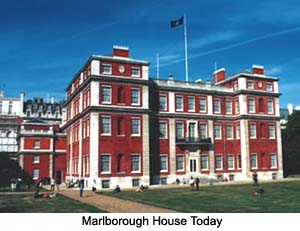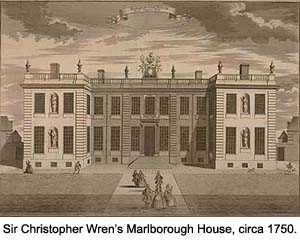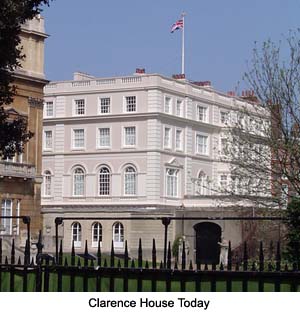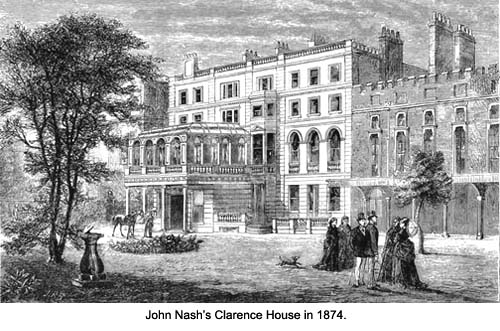Palaces on the Periphery:
Marlborough House and Clarence House
by Tori V. Martínez
Flanking historic St. James's Palace are two of London's most
underrated royal palaces. Arguably so, since, to some, the more
appropriate adjective used to describe both palaces would
probably be "underwhelming." Nevertheless, as in many
things, a little disagreement frequently creates an added element
of interest, and this is certainly the case for Marlborough House
and Clarence House.
Although both palaces were designed by the premier architects of
their day -- Sir Christopher Wren and John Nash, respectively --
neither one has received high accolades in more contemporary
times. Marlborough House is described in the 1986 book, The
Great Houses of London, as "a sorry sight" that has
been ruined by the many additions and alterations it has received
over time. As for Clarence House, in 1901, one American newspaper
unflatteringly referred to it as "the amorphous yellow
structure at the western end of St. James'." The following
year, a compatriot publication was only slightly less unkind when
it described the royal edifice as a "square saffron-colored
mansion."
Yet, despite these low descriptions, both Marlborough House and
Clarence House are important historically, hold great royal
significance, are good examples of their respective architect's
work, and today each serve a very important function --
Marlborough House as the seat of the Commonwealth Secretariat,
and Clarence House as the official residence of the Prince of
Wales and his family.
In with a Queen, Out with a Queen
 On the east side of St. James's Palace, separated by
Marlborough Road, is Marlborough House, the first of the two
palaces to be built and, as fate dictated, one of the last
private palaces to be erected during the reign of Queen Anne (r.
1702-1714). Not originally a royal home, it nonetheless owes its
creation to the special grants and privileges bestowed by Queen
Anne upon the great British hero, John Churchill, the first Duke
of Marlborough, and his wife, Sarah Churchill, Queen Anne's
favorite courtier. Along with the dukedom, the royal manor of
Woodstock, and a generous financial grant to build the fabulous
Blenheim Palace, Queen Anne also granted the Duke and his wife
the lease of several acres of land near the Queen's London
residence, St. James's Palace, on which to build a city palace of
their own. On the east side of St. James's Palace, separated by
Marlborough Road, is Marlborough House, the first of the two
palaces to be built and, as fate dictated, one of the last
private palaces to be erected during the reign of Queen Anne (r.
1702-1714). Not originally a royal home, it nonetheless owes its
creation to the special grants and privileges bestowed by Queen
Anne upon the great British hero, John Churchill, the first Duke
of Marlborough, and his wife, Sarah Churchill, Queen Anne's
favorite courtier. Along with the dukedom, the royal manor of
Woodstock, and a generous financial grant to build the fabulous
Blenheim Palace, Queen Anne also granted the Duke and his wife
the lease of several acres of land near the Queen's London
residence, St. James's Palace, on which to build a city palace of
their own.
The land grants were made in 1708 and 1709, by which point the
Duchess had already selected Sir Christopher Wren -- most
famously recalled for designing St. Paul's Cathedral -- as her
architect. On May 24, 1709, the Duchess laid the foundation stone
to the new palace, which she directed should be "plain and
cheap." Of course, by most standards, no palace is truly
plain and cheap, and Marlborough House was certainly no
exception, but the relatively simple and unornamented design was
a direct departure from the newly popular Palladian style, and a
complete departure from the ostentation that defined Blenheim
Palace. Perhaps the most outstanding and interesting feature of
the palace was the material used to construct it -- red bricks
that were said to have been brought from Holland to England as
ballast for the ships that had carried the Duke of Marlborough's
troops to Holland.
The house took three years to build, but the Duke and Duchess of
Marlborough did not have much time to enjoy the palace
immediately after it was completed, thanks to a falling out
between the Marlborough's and the Queen. After Queen Anne's
death, the Marlborough's made a triumphant return to their London
palace, which they both enjoyed until the Duke's death in 1722.
The Duchess occupied Marlborough House for another 22 years after
her husband's death, and the palace was eventually passed on to
the fourth Duke of Marlborough. With his death in 1817, the Crown
purchased the remainder of the original lease and Marlborough
House was earmarked as the home of Princess Charlotte, the sole
heir of the future George IV, and her new husband, Prince Leopold
of Saxe-Coburg. But Charlotte died following childbirth before
the house was ready, and it was her widowed husband who lived
there until 1831 when he became King of the Belgians.
As the succession of the rulers of the British monarchy
progressed, so did the fate of Marlborough House. After Leopold
vacated the premises, the palace was reserved for Queen Adelaide,
wife of King William IV (r. 1830 -- 1837) as a dower house.
Accordingly, she did not occupy the house until the death of the
King, but then lived there until her own death in 1849. After
Adelaide, Marlborough House was slated for the young Prince of
Wales -- eldest son of Queen Victoria -- when he came of age. He
officially took possession of the palace in 1863, along with his
new Danish bride.
No one since the first Duke and Duchess of Marlborough made such
a deep impression on Marlborough House as did Bertie and Alix,
the Victorian Era's longstanding Prince and Princess of Wales.
During the long, staid and formal years of Queen Victoria's reign
following the death of her husband, the Prince Consort, in 1861,
the circle surrounding the young and vibrant household of the
Prince and Princess of Wales was a beacon of light to the
"faster" set of London society. It didn't take long for
that set to become known as "The Marlborough House
Set." Led by the forward-thinking Prince, individuals were
permitted within this glittering sphere who would have been
unthinkable at any other time before, including the new rich,
Americans and Jews. In short, the Marlborough House Set was a
defining factor in helping to break down class barriers in
British society -- or, at least, it was a start.
 When they
weren't enjoying themselves and their society, Bertie and Alix
were fulfilling their duties as perpetuators of the royal family.
In 1865, their second son, Prince George -- the future George V
-- was born at Marlborough House. The Prince and Princess of
Wales and their young family used Marlborough House as their
London home for nearly 40 years until shortly after Bertie
succeeded to the throne in 1901 as King Edward VII. When they
weren't enjoying themselves and their society, Bertie and Alix
were fulfilling their duties as perpetuators of the royal family.
In 1865, their second son, Prince George -- the future George V
-- was born at Marlborough House. The Prince and Princess of
Wales and their young family used Marlborough House as their
London home for nearly 40 years until shortly after Bertie
succeeded to the throne in 1901 as King Edward VII.
After the new King and Queen made the move to Buckingham Palace,
Marlborough House was occupied by yet another Prince and Princess
of Wales, George and May, until they became King George V and
Queen Mary in 1910. On May 9, 1910, three days after the death of
Edward VII, two of the new King's sons -- themselves the future
Kings Edward VIII and George VI -- watched from the windows of
Marlborough House as their father was officially proclaimed King
George V in the Friary Court of St. James's Palace next door.
With the new reign, Marlborough House became a dower house once
again, this time to the Dowager Queen Alexandra, who occupied her
old home until her death in 1925. The cycle looked as if it would
repeat itself once more when the palace was offered to yet
another Prince of Wales, Prince Edward -- better known to his
family as David -- the future Edward VIII and, later, Duke of
Windsor. But David had little liking for the old palace,
preferring instead to live in the more intimate surrounds of York
House at St. James's Palace and his country home, Fort Belvedere.
As a result, Marlborough House was not to have another royal
inhabitant until Queen Mary moved there following the death of
George V in 1936, completing the cycle once again. The never
ending round of royal comings and goings was sadly echoed for the
old queen on February 15, 1952, when -- not unlike what her own
sons had done when their father was proclaimed king in 1910 --
Queen Mary watched from a window at Marlborough House as the
funeral cortege of her son, George V, passed along the Mall.
Following Queen Mary's death in 1953, Marlborough House went into
a state of limbo until the young Queen Elizabeth II decided that
the palace that was granted into existence by a historic queen
would be granted a new existence by a modern queen.
A "Stable" of Assorted Royals
 Without a doubt, Clarence House's beginnings were at
least a few degrees less auspicious than those of Marlborough
House. For one thing, whereas Marlborough House was built on
several acres and had some distance between it and St. James's
Palace, Clarence House was constructed in a somewhat more cramped
nook adjoining the west side of St. James's in Stable Yard. For
another, although the palace was designed by the noted Regency
architect John Nash, he was apparently reluctant to take on the
job. But he did, and Clarence House was duly built between 1825
and 1827 for the Duke of Clarence -- younger brother of King
George IV (r. 1820 -- 1830), and himself the future William IV. Without a doubt, Clarence House's beginnings were at
least a few degrees less auspicious than those of Marlborough
House. For one thing, whereas Marlborough House was built on
several acres and had some distance between it and St. James's
Palace, Clarence House was constructed in a somewhat more cramped
nook adjoining the west side of St. James's in Stable Yard. For
another, although the palace was designed by the noted Regency
architect John Nash, he was apparently reluctant to take on the
job. But he did, and Clarence House was duly built between 1825
and 1827 for the Duke of Clarence -- younger brother of King
George IV (r. 1820 -- 1830), and himself the future William IV.
Originally, Clarence House was "a three-storey mansion of
classical proportions," with the façade featuring the
stucco that was a trademark of most of Nash's designs. Around the
same time, just around the corner, Nash was making far more
imposing changes to what we know today as Buckingham Palace for
George IV, but Clarence House was still a respectable royal
palace. And though not a particularly grand one, it suited the
relatively simple tastes of the Duke and Duchess of Clarence.
When the Duke succeeded his brother as William IV in 1830, he and
the new Queen stayed on at Clarence House, making it a center of
Court activity until his death in 1837.
Since Marlborough House had been set aside for Queen Adelaide as
a dower house, Clarence House next became the London residence of
the late King's sister, Princess Augusta, until her death in
1840. Almost without skipping a beat, Clarence House then passed
to Queen Victoria's mother, the Duchess of Kent. Considering the
Duchess and Clarence House's founder and namesake hated each
other, poor William IV was probably rolling in his grave over
this development.
Five years after the Duchess of Kent's death in 1861, Queen
Victoria's second son, Prince Alfred, Duke of Edinburgh, took up
residence at Clarence House. When he married the Grand Duchess
Marie Alexandrovna of Russia -- the only daughter of Tsar
Alexander II -- in 1874, Clarence House was renovated, modified
and expanded to four-stories. The Duke and Duchess of Edinburgh
lived in the house until the Duke died in 1900, although they had
used it less frequently after 1893 when the Duke became the Duke
of Saxe-Coburg and Gotha and moved to Germany to take up his
responsibilities. During their time in the palace, it gained a
reputation of being one of the most elegantly furnished homes in
London and was supposedly famous for its "good beds."
In 1901, another of Queen Victoria's sons, the Duke of Connaught,
and his wife moved into Clarence House, and it remained the
Duke's London residence until his death in 1942. With the Second
World War raging, the palace was then lent to the cause for the
duration.

The next occupants of Clarence House reflected the previous
two royal occupants in a very unique way. As Duke and Duchess of
Edinburgh, Lieutenant Philip Mountbatten and Princess Elizabeth,
heir to the throne and today Queen Elizabeth II, were the second
couple holding that title to live there. In addition, the Duke of
Connaught was the great uncle of both Philip and Princess
Elizabeth.
The plan to have the Princess and her husband live in Clarence
House was devised in 1947, although since the usual need for
renovations between royal occupants was exacerbated by damage
done to the palace during the war, they didn't actually move in
to Clarence House until 1949. According to a newspaper report of
the day, the renovations involved, among other things,
"ripping out or refurbishing yards and yards of crimson
carpeting," and painting the palace a shade of "creamy
yellow." Once settled into their new home, the couple lived
a relatively domestic life, and it was in Clarence House that the
Princess gave birth to her second child, Princess Anne, on August
15, 1950.
Following Elizabeth's accession to the throne in 1952, she
switched places with her mother, Queen Elizabeth the Queen
Mother, when the new Queen moved into Buckingham Palace and the
old Queen moved into Clarence House along with Princess Margaret.
The room in which the young Princess Elizabeth had given birth to
Princess Anne became the bedroom of Princess Margaret. Years
later, in November 1961, Princess Margaret, who had married the
previous year, returned to that same room to give birth to her
first child, David Armstrong-Jones, Viscount Linley.
The Queen Mother lived at Clarence House for nearly 50 years,
making her name seem almost exclusively synonymous with the
historic royal palace. It's impossible to give attention to every
one of the multitude of important events and personages that
passed through Clarence House during the Queen Mother's
residence, but at least one individual is certainly worth
mentioning here. In February 1981, Lady Diana Spencer moved into
Clarence House with the Queen Mother on the eve of the
announcement of her engagement to Prince Charles, the Prince of
Wales. Little else needs to be said on that matter, but it wasn't
without a little bit of irony when, following the Queen Mother's
death in 2002, Clarence House passed to Prince Charles.
New Roles for Old Palaces
Although Marlborough House had generally been a beloved and
well lived-in home for most of its history, after the death of
Queen Mary in 1953, the 200-room palace was quickly deemed by the
royal family to be too outmoded for modern living and too
expensive to maintain, and it was soon passed on to the British
Government. From an aesthetic point of view, it is probably true
that at least part of the downfall of Marlborough House was due
to the many renovations and additions it received over its long
history. What began as a straightforward two-story building was,
by the 19th century, a somewhat disjointed four-stories. Because
of that, Marlborough House is considered by many to be a mere
shadow of its more palatial neighbor, Lancaster House, although
it is still, as Muirhead's Short Guide to London called it
in 1928, "a good example of Sir Christopher Wren's red brick
work."
Home today to the Commonwealth Secretariat, the central body of
the Commonwealth of Nations, Marlborough House was most recently
remodeled between 1989 and 1993, just a few years after it was
called "a sorry sight." Criticisms by the architectural
die-hards aside, a palace is still a palace, and the
façade is sufficiently impressive to please the average
person. Not to mention the fact that many of the interior spaces
are satisfactorily grand, even after dozens of interior
renovations by successive royal occupants and a major overhaul to
convert it to government use. Perhaps one of the few elements of
Marlborough House still somewhat close to original condition is
the garden, which is said to be maintained largely as it was in
the 18th century.
For lovers of royal history, Marlborough House holds a number of
added physical and sentimental attractions. On the west side of
the palace, facing Marlborough Road, is a bronze memorial to
Queen Alexandra dating from 1932 and designed by sculptor Sir
Alfred Gilbert. The palace also has strong connections to the
Duke of Windsor who, as King Edward VIII in 1936, informed his
mother, Queen Mary, at Marlborough House that he was determined
to marry his American mistress, Wallis Simpson, even if it meant
giving up the throne. More than 30 years later, in 1967, the long
exiled and ostracized Wallis Simpson, as Duchess of Windsor, was
invited for the first time to attend an event hosted by the
British royal family. The event was the unveiling of a memorial
plaque to the late Queen Mary at Marlborough House.
Like Marlborough House, Clarence House has also changed a great
deal since it was built, owing to major alterations in the 1870s,
numerous renovations, and the German bombs of the Second World
War. In addition to no longer being "saffron" yellow,
the most recent renovations modernized Clarence House for
comfortable habitation by the Prince of Wales and his two sons,
Princes William and Harry, and, more recently, by the Prince of
Wales' new wife, the former Camilla Parker-Bowles.
Despite the renovations and the new occupants, Clarence House is
still most often associated with Queen Elizabeth the Queen
Mother. The official word from Buckingham Palace is that the
rooms and the much of the furnishings are still very much as they
were in the Queen Mother's time. Considering that the Prince of
Wales was very close to and fond of his grandmother, this comes
as little surprise.
It's likely that the less palatial size of Clarence House has
enabled it to remain a functioning royal palace, unlike
Marlborough House. Although Clarence House doesn't have quite so
long a history as its neighbor, or the physical monuments, it
does boast some very important modern royal residents. And while
Prince Charles is certainly not the first heir to the throne to
live at Clarence House, he does hold the distinction of being the
first Prince of Wales to occupy the palace.
As palaces on the periphery, Marlborough House and Clarence House
may not be London's most notable, visible, or architecturally
significant historic royal palaces, but both have unique and
fascinating characters that make them far from underwhelming --
and well worth visiting.
Both palaces are working buildings, so have restricted opening
times; however, both can be toured to a limited degree at
specified times. Tours of Marlborough House are available Monday-Friday for groups of 15-30. The palace is
also sometimes open to the public during Open House London each
September. A limited number of ground floor rooms in Clarence
House are open to the public by pre-booked tickets from August to
early October, except on certain days.
More Information:
We regret that we no longer have the resources to maintain up-to-date links and/or hours and pricing details for the various sites and attractions listed on this website. For more information about the location(s) listed above, please use your favorite search engine or visit Wikipedia.
Tori V. Martínez is a writer and freelance public relations professional who spends as much time as possible researching and writing on her favorite subject -- history. Several years ago, Tori eschewed the life of a full-time career woman to travel and live around the world, particularly in Britain, where she spent considerable time exploring and researching historic destinations. At the moment, she is living in the US with her husband -- a Spaniard she met in England -- and is happily writing for a variety of online and print publications.
Article © 2006 Tori V. Martínez
Photos courtesy of Wikipedia.org
|
